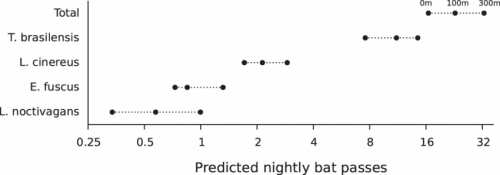May 16, 2014 report
Study confirms highways are bad news for several bat species

(Phys.org) —Large roads and highways have been shown to reduce the numbers of many species that live near them. Previously, this effect has been mostly studied in birds. But a recent research paper, published in the science journal PLOS ONE, has shown that close proximity to highways reduces the activity of four bat species native to California.
Other research has confirmed that one of the biggest human impacts on the environment is road construction. Apart from the initial habitat destruction caused by clearing areas to build highways, roads tend to break up the environment into fragments, which means wildlife cannot migrate freely. This stops the flow of genes across landscapes, which reduces the genetic health of wildlife.
Many papers have documented the effect of traffic on wildlife behaviour and abundance. For example it was found the grey shrike-thrush sang at a higher frequency, if there was a lot of traffic noise, than other bird species such as the grey fantail. And that the number of both species declined substantially with increasing traffic noise and traffic volume. It has also been shown that some species of rainforest frogs are less abundant near large, busy roads.
But there has been less research into the effects that large roads have on bat populations. Dr Justin Kitzes and his colleagues at the University of California, Berkley, set out to investigate how roads impacted the activity of several bat species native to the area in question—these were the Brazilian free-tailed bat, big brown bat, hoary bat and silver-haired bat.
Kitzes and his team concentrated on three major highways in California. The researchers set up an acoustic recording system for each highway. Microphones were set up on one metre poles along a transect perpendicular to the highway to record the calls of bats which happened to fly by them. These microphones were placed at 20, 100 and 300 metres from the edge of the road. The habitat varied between transects. For example, some transects consisted of bare sand and open water, whereas others consisted of marshland with intermittent trees.

The recordings were taken between sunset and sunrise over the course of about a month in the autumn of 2011. Every time a bat flew past a microphone, its call was automatically recorded. Different species of bat were later distinguished by playing back the recordings and identifying their specific calls. Activity was measured at each of the three microphones by counting the number of bat calls that were recorded per night; bat activity could then be compared at varying distances from the highway.
Statistical analysis was then completed to find if bat activity varied with distance from the road, and the results were highly significant. Kitzes said, "the key finding is that we find fewer bats near large roads - highways in our case - which suggests that these roads decrease the amount of suitable habitat for bat species". It was also found that bats were generally more active in warmer temperatures.
Kitzes went on to say that the results were expected, given that previous research has shown that large roads and highways are generally bad news for the native wildlife. But the effect of roads on bat activity may have been larger than some expected. It was found that there was around a 50 percent decrease in activity in bats recorded right next to the highway when compared to bats recorded 300 metres from the highway, a relatively large effect for such a small distance. And this effect was consistent across all four species.
The current research paper did not attempt to decipher the mechanisms behind the road effect. But possible explanations include traffic noise, headlight illumination, or changes in wind speed (due to passing traffic) affecting the bat's ability to hunt.
Kitzes added, "If these results are confirmed with further studies, especially those that are able to identify the mechanism causing the road effect, future road construction and maintenance projects might need to consider accounting for the associated reduction in bat habitat as part of their impact assessments."
More information: Kitzes J, Merenlender A (2014) Large Roads Reduce Bat Activity across Multiple Species. PLoS ONE 9(5): e96341. DOI: 10.1371/journal.pone.0096341
Journal information: PLoS ONE
(c) 2014 Phys.org


















